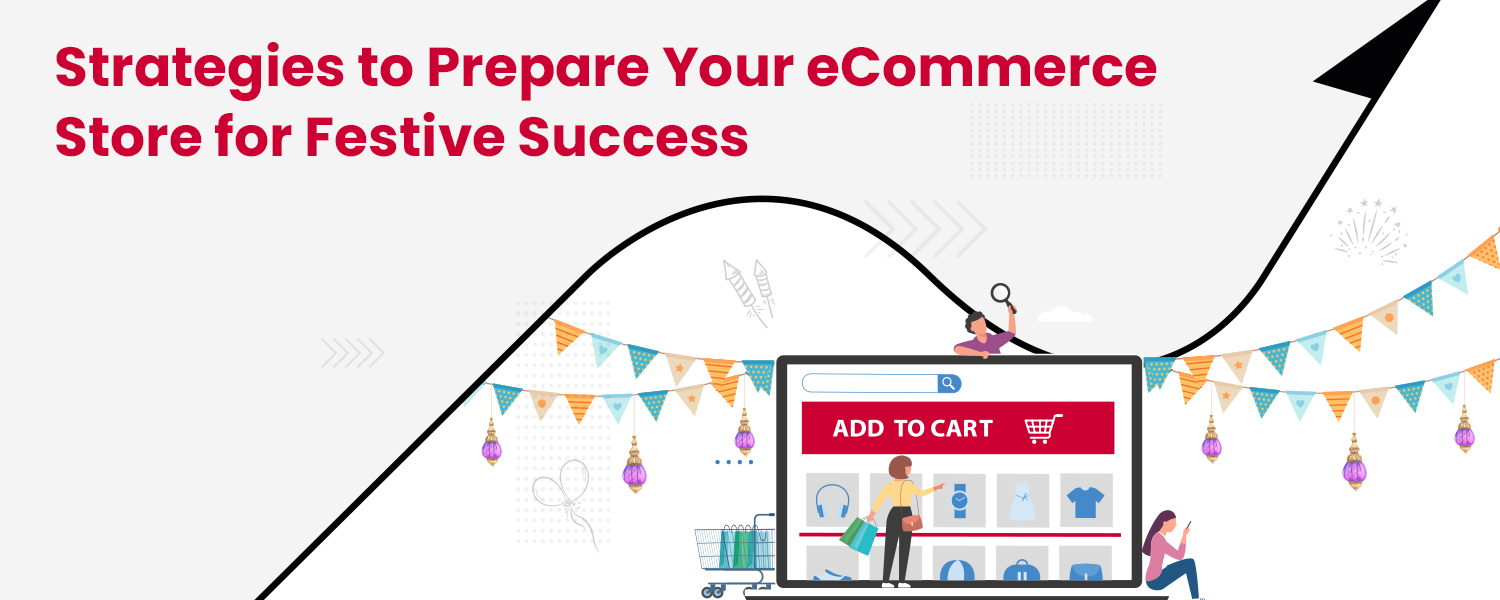The festive season is always a shopping frenzy unlike any other. Especially in India because our festivals are deeply rooted in religious diversity. People enjoy shopping during festivals, and October, November, and December are synonymous with festive seasons in India and worldwide. Over 90% of consumers shop during these months. Therefore, e-commerce share of the retail market remains staggeringly high during the festive seasons.
The digital marketplace is thriving, marking a 14.7% increase year-over-year growth. More than half of the consumer population plans to fill virtual carts rather than physical ones. That’s more clicks of a mouse over the hustle of in-store shopping.
This means opportunity; your customers are looking for an easy, flexible, and personalised shopping experience, and they’re looking for it now. Let’s see how to serve them.
This guide isn’t just another run-of-the-mill blog. This has the ten strategies to becoming the go-to destination for holiday shoppers. We’ve tapped into the minds of eCommerce experts across the industry to bring you insights that will leave no stone unturned.
Steps for Preparing for the 2023 Holiday Season
Analyze and Learn from Past Data
Let’s put it this way: Would you go into battle without studying your enemy’s tactics? Absolutely not. Right!! Last year’s data is your playbook, which reveals what worked, what flopped, and what could be the game-changer this year.
So, what questions should you be asking as you sift through last year’s data? Start with your marketing campaigns. Which ones had your customers clicking ‘Add to Cart’ faster than you can say ‘holiday discounts’? Identify the elements that made those campaigns successful.
Zero in on your most popular products. Understanding why these products were hits can offer invaluable insights into customer preferences. And do not forget to check how much revenue you rake in during this period. What was the average order value? These financial metrics are a crucial test of your store’s performance. Finally, take a peek at what your competitors were up to.
Optimise Your Website for High Traffic
High traffic is a good problem, but only if your website is equipped to handle it. Think of your website as a physical store. If too many people try to enter, the doors will jam, and chaos will ensue. The same principle applies to your online store. If your website isn’t optimised for high traffic, you risk losing sales and damaging your brand’s reputation.
Your first call should be to your hosting provider. Reach out to them and inquire about your current hosting plan’s capabilities. How much traffic can it handle? Is there an option to scale resources quickly in case of a traffic spike?
Apart from this, work on the nitty-gritty of website optimisation. This includes reducing image sizes and leveraging browser caching to optimise code and improve server response times.
Inventory Management
According to Shopify, last year’s global sales totalled a staggering $6.3 billion during Black Friday and Cyber Monday alone. With such high stakes, you can’t afford to underestimate the importance of effective inventory management.
Don’t rely on gut feelings or rough estimates if you’re wondering how much stock to keep. Turn to the hard data from your past performance. What were your most popular products last year? Which items flew off the virtual shelves, and which ones barely got a second glance?
Once you’ve crunched the numbers, coordinate with your suppliers. Ensure they can meet your demands and inquire about lead times.
But what if you overestimate demand? While having excess stock is less damaging than running out, it still ties up capital that could be better used elsewhere. That’s why run flash sales or offer them as bonuses to move excess stock quickly.
Get into the Holiday Spirit: Website Aesthetics
Your eCommerce website is your virtual storefront, and just like a brick-and-mortar store, it needs to get dressed up for the holiday season.
A lot of people look for a festival gift, and your website’s aesthetics can be the difference between a browser and a buyer. A well-decorated website can evoke the holiday spirit, making visitors more likely to engage, browse longer, and, ultimately, hit that “Add to Cart” button.
Mobile Optimisation
We’re living in a mobile-first world. Today, the smartphone is the shopping cart, the checkout line, and the retail store all rolled into one. And during the festive season, this trend is even more pronounced.
A mobile-optimised site offers the flexibility to shop while on the go, turning those spare moments during a lunch break into potential sales opportunities.
Optimising your eCommerce site for mobile isn’t just about shrinking your desktop site to fit a smaller screen. It’s about rethinking the user experience from a mobile perspective.
Improve your website load time on mobile, compress images, leverage browser caching, and minimise code to improve load times. Make sure your buttons are easily clickable and your menus are simplified and intuitive. Implement features like collapsible menus and swipeable product images to make navigation a breeze.
Lastly, streamline the checkout process, offer multiple payment options, and consider one-click checkouts to make the transaction as smooth as possible.
Enhance Site Navigation and Search Functions
Poor site navigation and ineffective search functions can turn your online store into a complexity that shoppers can’t wait to escape. And during the high-stakes, high-traffic festive season, you simply can’t afford to lose customers to a poorly designed user interface. 70% of eCommerce search implementations are unable to return relevant results for product-type synonyms, thereby missing out on potential sales. Therefore, your search function should not only be fast but also intelligent, capable of understanding user intent, offering auto-suggestions, and even correcting typos.
Now, let’s pivot to site navigation. The goal here is simple yet profound:
- Make it as easy as possible for customers to find what they’re looking for.
- Start by organising your products into intuitive categories and sub-categories.
- Use clear, descriptive labels for your menu items.
- Consider adding special categories like “Holiday Gifts” and “New Year Essentials” during the festive season to capitalise on seasonal shopping trends.
Leverage Email Marketing
Email marketing might seem like yesterday’s news in the age of social media and PPC ads. But let’s set the record straight: Email marketing can be a game-changer, especially during the festive season.
During the festive season, start by segmenting your list based on customer behavior, purchase history, and engagement levels. Tailor your email campaigns to these specific segments.
Some email flies under the radar but holds immense potential—transactional emails. These are the emails your customers receive after making a purchase, like order confirmations and shipping notifications. You might think these emails are just procedural formalities, but they’re actually ripe opportunities for upselling and cross-selling. During the festive season, you can also use these emails to promote limited-time offers or last-minute gift ideas.
Boost Social Media and Content Marketing
You might already have a presence on platforms like Facebook, Instagram, and Twitter, but the festive season calls for something extra.
Ramp up your posting frequency with holiday-themed content. Showcase your special festive offers, gift bundles, and limited-time discounts. Use eye-catching visuals and compelling copy to make your posts shareable.
Run interactive campaigns like holiday contests or polls. Ask questions like, “What’s on your wish list this year?” or “Which holiday bundles do you find most exciting?” The goal is to foster community and engagement around your brand.
While social media gives you the stage, content marketing is the performance. Create a content calendar specifically for the festive season. Plan blog posts offering genuine value, like gift guides, holiday recipes, or decoration ideas. These posts serve a dual purpose: they’re useful to your audience and help improve your site’s SEO.
Expand your content and include videos, podcasts, or webinars. Remember, the more diverse and valuable your content, the higher the chances of sharing it, and the greater the traffic to your eCommerce store.
Special Offers and Incentives
Through special offers and incentives that not only lure customers but also make them feel valued. Let’s unwrap this gift of a strategy.
Gift Wrapping
Offering gift wrapping is like offering convenience on a silver platter. You’re saving your customers the hassle of wrapping gifts themselves, which is especially appealing during the busy holiday season. Plus, beautifully wrapped gifts enhance the unboxing experience, making it memorable for the recipient and scoring extra points for your brand.
Gift Cards
Gift cards are the perfect solution for the indecisive shopper. Offering gift cards can be a game-changer for your eCommerce store as they often lead to higher spending. According to research, recipients are likely to spend more than the gift card’s value, making it a strategy that pays for itself.
Free Shipping
In an era where instant gratification is the norm, the added cost of shipping can be a deal-breaker. Offering free shipping not only removes this barrier but also adds an irresistible offer. Take it up a notch by setting up free courier services in peak season. For example, “Free shipping on orders over INR 1500.” This encourages customers to add more items to their cart, subtly increasing your average order value.
Stellar Customer Service
Customers have questions, concerns, and last-minute decisions that could make or break their holiday celebrations. This is where customer service steps in.
Spotlight on Customer Service Options
First things first, your customer service options should be visible. Whether it’s a helpline number, an email address, or a ‘Contact Us’ form, make sure these touchpoints are easily accessible from any page on your website.
Live Chat
Millennials, who make up a significant portion of online shoppers, prefer live chat for its immediacy. A well-executed live chat can answer queries, solve problems, and even upsell products in real time, offering a seamless shopping experience.
Clear Shipping and Return Policies
A transparent and easily accessible shipping and return policy can alleviate customer anxieties. Clearly state delivery timelines, return conditions, and any associated costs. The more transparent you are, the more confident your customers will feel and the more likely they are to hit that ‘Buy Now’ button.
Conclusion
As the confetti settles and the festive lights dim, the true measure of your eCommerce store’s success will shine through in your sales figures and customer satisfaction levels. So don’t let this golden opportunity slip through your fingers. With the strategies we’ve laid out, your store can become the go-to destination for holiday shoppers.
But there’s a cherry on top– NimbusPost. From reducing RTO by up to 25% to offering competitive shipping rates, NimbusPost is a logistics aggregator you may have been waiting for to reduce package delivery time and grow your eCommerce business during the festival season. Our advanced technology ensures that your products reach even the remotest locations, ensuring your festive sales are not just confined to urban landscapes.
So, why juggle multiple courier partners when NimbusPost can streamline your logistics with a single, efficient platform? Our services are especially invaluable during the high-demand festive season, ensuring your products reach customers quickly and efficiently. Sign up for NimbusPost today and transform your logistics from a complicated puzzle into a strategic masterpiece.
FAQs
What are the strategies used for making eCommerce businesses successful?
In order to ensure the success of an eCommerce business, it is necessary to implement a number of key strategies.
SEO Optimisation: Enhance website visibility through effective SEO techniques to rank higher in search engine results.
User-Friendly Design: Ensure the website is easy to navigate, mobile-responsive, and has fast load times.
High-Quality Content: Use engaging and informative content to educate customers and improve SEO.
Customer Reviews: Showcase customer testimonials and reviews to build trust.
Personalisation: Use data analytics to offer personalised recommendations and deals to customers.
What strategies should be adopted for eCommerce?
To optimise eCommerce success, consider the following strategies:
Email Marketing: Send personalised emails to nurture leads and inform customers about promotions.
Data Analytics: Use tools like Google Analytics to track KPIs and customer behaviour for data-driven decisions.
Customer Reviews: Encourage and display customer reviews to build trust.
Inventory Management: Keep an accurate stock count and update your website accordingly to avoid overselling.
Payment Options: Offer multiple payment methods for customer convenience.
Customer Support: Provide excellent customer service through live chat, FAQs, and easy return policies.
What are the factors necessary for the success of eCommerce?
To achieve success in eCommerce, consider the following key factors:
User-Friendly Website: Ensure an intuitive, easy-to-navigate platform.
High-Quality Products: Offer reliable and desirable items.
Secure Payment Options: Implement multiple secure payment methods.
Fast Shipping: Provide quick and reliable delivery services.
Customer Support: Offer 24/7 customer service through various channels.
SEO Optimisation: Utilise SEO strategies to improve website visibility.
Mobile Responsiveness: Ensure the website is mobile-friendly.
Marketing Strategies: Use digital marketing, including social media, to attract customers.




